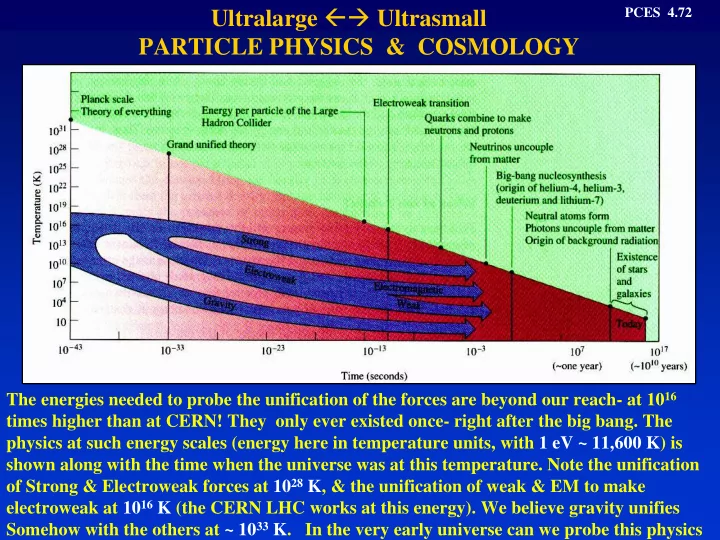

Ultralarge �� Ultrasmall PCES 4.72 PARTICLE PHYSICS & COSMOLOGY The energies needed to probe the unification of the forces are beyond our reach- at 10 16 times higher than at CERN! They only ever existed once- right after the big bang. The physics at such energy scales (energy here in temperature units, with 1 eV ~ 11,600 K) is shown along with the time when the universe was at this temperature. Note the unification of Strong & Electroweak forces at 10 28 K, & the unification of weak & EM to make electroweak at 10 16 K (the CERN LHC works at this energy). We believe gravity unifies Somehow with the others at ~ 10 33 K. In the very early universe can we probe this physics
PCES 4.73 Seeing to the Edge of the Universe The 2 main tools giving us our understanding of the early universe are (i) powerful earth-based radio telescopes, and (ii) optical telescopes, principally the Hubble Space Telescope (HST). Although the HST mirror is only 2.5 m in diameter, there is no atmospheric interference, and it can take week-long exposures. Radio telescope arrays connect dishes far apart, giving v high resolution. Orbiting telescopes are also designed to see in the The HST (above) & its launch IR, UV, X-rays, and Gamma rays (none of which (below right) penetrate the atmosphere). LEFT: The Cos-B satellite under construction. It carries The VLA (Very Large Array), a set of 26 dishes, a gamma-ray telescope each of 25 m, which can be moved along rails stretching 15 miles from the centre
PCES 4.74 Cosmic Distance Scales Measuring large distances is complex. Cepheids play a crucial role- these giant pulsating stars have pulsation time simply related to their luminosity. They can be seen out to ~ 10 8 light yrs with ABOVE: Close-up of NGC 4603- some NGC 4603, @ 108 million lt. yrs Cepheids are identified in boxes modern telescopes- we know their real luminosity because some Cepheids are near enough to have their distances measured in other ways (parallax, etc). At much greater distances one relies on supernovae, whose luminosity is known fairly accurately from their spectra. These are so bright they can be seen as far as the farthest galaxies. From all this work we find that the radius of the visible universe is ~ 14 billion (1.4 x 10 10 ) light years, & the age of the universe is ~ 1.4 x 10 10 yrs LEFT: Supernova in HST deep field- note difference between 1996-7.
PCES 4.75 Theories of the Early Universe Theories of the early universe try to combine ideas about string and/or particle physics with gravity theory. This is hard without a proper quantum theory of gravity. There are very strong theoretical reasons for a modified Big Bang which begins with the quantum tunneling of all of spacetime from a ‘false vacuum’ state into the present universe (in a way reminiscent of the nucleation of a new phase) followed by a period of extremely fast expansion, or ‘inflation’ (above), and finally a long period of Hubble expansion, which still goes on. At pres At present the b ent the best way of t way of testing th sting these ideas is t ese ideas is to look in look in gr great detail eat detail at the di at the distri stribution of th bution of the m e microwave crowave radiation in the s diation in the sky – y – this is a relic fr his is a relic from the time om the time when radiation decoupl when radiation decoupled d from matter shortly after the Bi from matter shortly after the Big Bang. g Bang. This idea g This idea goes b es back t ck to wor work in the k in the 1960’s from the extraordina 1960’s from the extra inary Rus y Russia ian n theorist Ya eorist Ya B Zeld B Zeldovich, one of t ovich, one of the fou e founders rs of modern r of mod rn relativis lativistic as ic astr trop ophysics. hysics. However there is a twist. In However there is a twist In recent yrs it has been found recent yrs it has been found th that most of the univ at most of the universe is in erse is in the for th e form of of DARK MATTER DARK MATTER , , th the nature of which i e nature of which is a a complete mystery. The gravity complete mystery. The gravi y from this changes the way in from this changes the way in which the early universe which the early universe Predictions of mass distribution YB Zeldovich evo evolved ved. Simulations of mass distribution in from Zeldovich theory (1914-1984) early universe, including dark matter
PCES 4.76 Early Moments of the Universe LEFT: a variety of Universes RIGHT: COBE map anisotropic µ wave background There is now good evidence that the early universe indeed went through a period of very rapid expansion (inflation), followed by a slower uniform expansion- according to recent evidence now slowly accelerating. This comes from measurements of tiny fluctuations in intensity of the microwave background, left over from the big bang. These fluctuations later self-gravitated into galaxies. The inflation scenario explains the small size of these fluctuations (a fraction ~ 10 -5 of the total µ wave background). Other pieces of the p Other pieces of the puzzle come zzle come from the distributi from the distribution on of gal of galaxies xies in the early universe, inferred by in the early universe, inferred by deep s eep space phot ace photograp ographs of s of galaxies and supernovae galaxies and supernovae FAR LEFT: Use of supernovae to follow expansion of universe NEAR LEFT: new galaxies in HST deep field photo
Recommend
More recommend